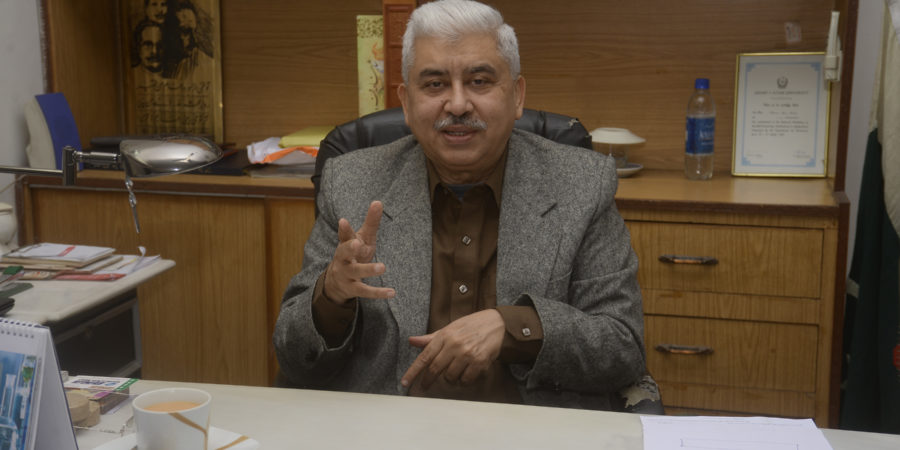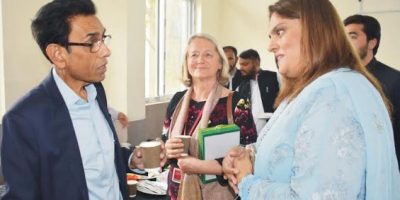Hasnain Raza Mirza: Golden Ring Economic Forum a landmark initiative

Hasnain Raza Mirza is President of Golden Ring Economic Forum (GREF). He talked to Centreline and DNA about various aspect of the Gref. Here is the first part of his interview. Second part shall appear in the next issue of Centreline
DNA
What forced you to form the Golden Ring Economic Forum (GREF)?
From the start of civilizations all geopolitical activities were based on economic interests of a nation or the rulers. With the passage of time definitions kept changing but the actual base remained the same. Similarly, the definition of “Strategic Depth” has also changed in today’s world. Now the Strategic Depth is no more a physical land depth but it is economic depth and security. The concept discussed herein is based on this definition.
The requirement of formation of five countries strategic chamber of commerce and industries was first discussed at LCCI in a meeting of its Standing Committee for OIC in December 2010. This initiative was launched by the Convener of Standing Committee. The participants decided that due to the critical nature of the issue the President LCCI should be given a briefing suggesting him to take up the matter in the first round of meeting with the M/o Foreign Affairs (MOFA). During the first round of meeting held at MOFA in February 2011 the desire was also voiced that LCCI must actively pursue this initiative to provide basis for political maneuvering for MOFA. Due to very sensitive nature of matter it had also been unanimously decided that the LCCI shall spearhead the initiative in close coordination and cooperation from MOFA, without the involvement of FPCCI. The matter was formally put as agenda part for the 2nd round of LCCI-MOFA meeting in 2012. It had been agreed upon that in the light of rapidly changing geo-political scenario in the region, post 2014 situation in Afghanistan and resulting fall out, Pakistan definitely needs to have strategic economic alliances in the region for its security, sooner the better. This initiative once successful, will be a prelude to formation of a new economic block.
The LCCI proposal for formation of five countries strategic chamber having two seats for Pakistan (LCCI as founder Chamber and FPCCI as national chamber) was adopted for further working. The Additional Secretary (EC&UN) MOFA proposed that from MOFA side his Office shall nominate a Director General to coordinate and be a member of the team. Whereas, Mr. Hasnain Reza Mirza, the Convener LCCI S/C for OIC, had been nominated by the President LCCI, to lead the team. It has also been agreed upon to keep the whole Project confidential and at profile in the beginning. It has been proposed to involve NUST, NDU and Institute of Strategic Studies also as members of the team.
This Concept Working Paper is based on a Situation Paper in by the Convener, LCCI Standing Committee for OIC December 2011. The Situation Paper was an analysis of abstracts, clippings and cuttings of texts in available articles, research papers and other relevant printed and published material. Later in 2012 after the 2nd Round Meeting with MOFA it was modified to become a Concept Working Paper. It discusses reasons for this initiative based upon analysis of available information related to present geo-political situation in the region, its historical background, military and strategic designs of different powers in and for the region.
Historically, the region starting from coasts of Mediterranean to the islands of Japan had been the area of major civilizations and therefore, of all adventures. Secondly, the Central/ South Asia and Gulf regions are full of valuable natural resources therefore,all big powers will like to have their dominance here. Pakistan’s location in the region is very importance. It is sitting on the mouth of Persian Gulf close to the Strait of Hormuz in the South and bordering Central Asia and China in the North, becoming the shortest route to warm waters. The doctrine of geographical strategic depth has net only become obsolete but also has proved to be wrong. It has failed miserably because one, it was made by a very closed group of single track people and second because the strategic economic security aspect was totally missing. Today, none of Pakistan’s boarders are safe. Pakistan does not enjoy support of Afghanistan, especially the Northern Afghans. We have spoiled our relation with Iran. Russia is also not pro-Pakistan either. India has played well it’s not only its card cards but also made best use of Pakistan’s blunder. Today, we have a war going on our North Western and Western frontiers, entire Southern border is hostile and our sea coast is packed with Allied Navy checking each and every versal at their will end ready to block Pakistan’s trade routes as and when required. They are also blocking the free entrance to warm waters for China and Russia.
This Paper discusses heavy concentration of Allied Naval forces in close proximity of Pakistan’s coast line (both Arabian Sea and Persian Gulf), US initiated Indian backed plan of New Silk Road Project, China, Land Bridge Program, future role of Iran, Turkey, Saudi Arabia and Israel in the region and the impacts of silent tussle between US and UK to get control of the region. An analysis of the entire scenario vis-à-vis Pakistan’s situation and state of affairs has been made. Although, Pakistan is a nuclear power with second largest (after India) forces in the region but economically is among the weakest most countries. Pakistan has no economic depth in the region, its eighty percent of the total trade is only with twelve countries. A conclusion has been drawn based on analysis that it is in the interest of Pakistan’s National Security to have strategic economic depth and strong economic partners in the region.
- INTRODUCTION
The circumstances and reasons which gave rise to the need to form such a chamber are based upon analysis of historical events, present international and regional geopolitical scenario and future desires and plans of US, UK, China, Russia Israel and India for the region and requirement of strategic economic depth for Pakistan. The following sections briefly discuss and analyze all this.
- HISTORICAL OVERVIEW.
The Silk Road is a historically important international trade route between China and the Mediterranean. Because silk comprised a large proportion of trade along this road, in 1877, it was named ‘the Silk Road’ by Ferdinand von Richthofen, an eminent German geographer.
The Silk Road (sometimes also called as Silk Route) comprised a series of land and sea trade routes that crisscrossed Eurasia from the first millennium B.C.E. through the middle of the second millennium C.E. The intersections among people from diverse cultures along the way promoted an unprecedented sharing of commodities, ideas, arts, sciences and innovations.
During the Han Dynasty (260BC-220 AD), trade of Chinese silk started through this historical road. The Silk Road (Fig-1) was a collection of trade routes dating back more than 3,000 years. The routes connected China, India, Persia, Arabia, Egypt and Rome. Present day countries on this Road include China, Turkey, Egypt, Iraq, Syria, Eastern Mediterranean, Arabian Peninsula, Iran, southern Russia, Afghanistan, Central Asia and Pakistan. During the Middle Ages, trade caravans would start from the modern Chinese city of Xi’an to Kashgar and take one of two routes: either to the Caspian via the plains of Afghanistan or to Anatolia over the mountains of Karakorum and Iran. From Anatolia, further progress to Europe was possible by sea over the Mediterranean and the Black Sea or by land over Thrace.
Related News

FPCCI Vice President advocates for closer academia-industry collaboration
ISLAMABAD, APR 26 /DNA/ – Qurat ul Ain Vice President Federation of Pakistan Chamber ofRead More

Soyabean, palm oil imports grew 53.07%, 28.55% in 09 months
ISLAMABAD, APR 24 (DNA) —Edible oil imports including soyabean and palm into the country during theRead More


Comments are Closed